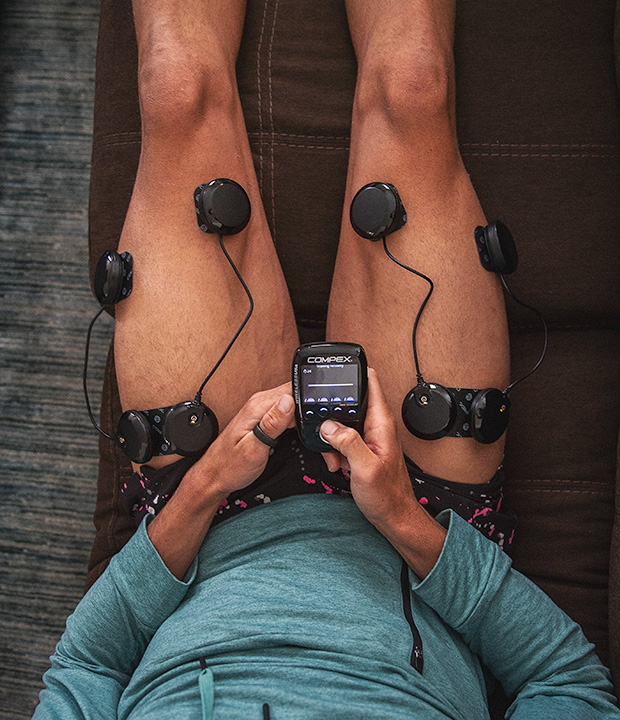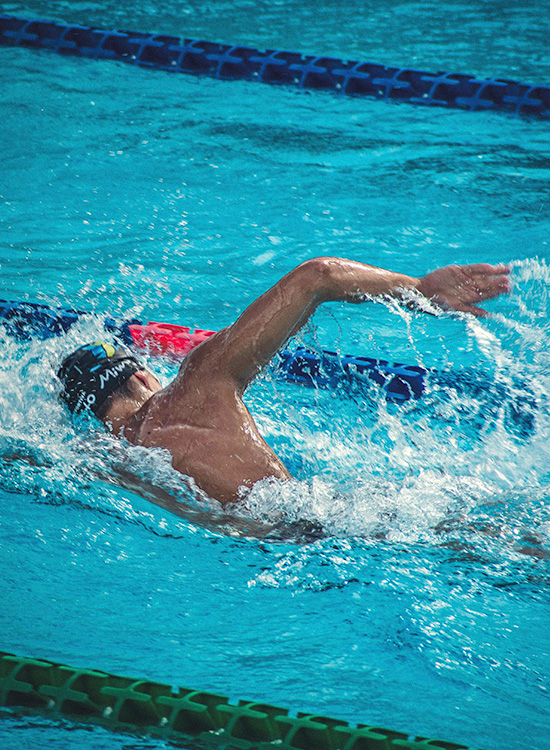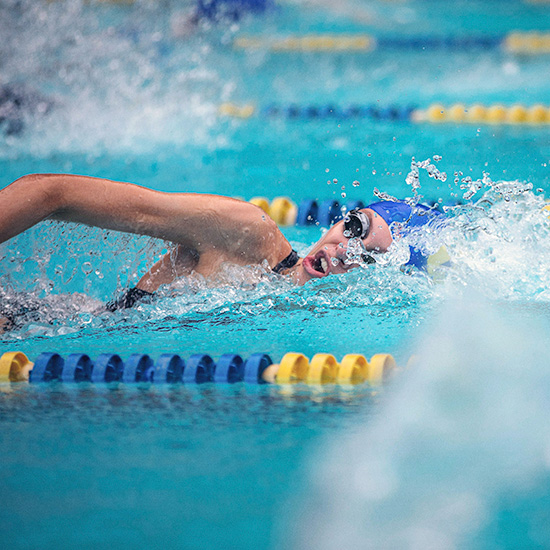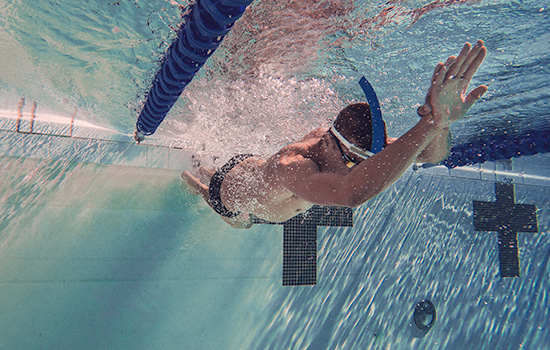Truly in a league of its own, swimming is the one exercise that takes place in an element that is not air. While any other sport occurs on land, the variations of swimming, whether from freestyle to water polo bring about another challenge: Breathing without consistent access to oxygen. Swimming inherently introduces a range of challenges unique to the sport for athletes to take into consideration when training. Perhaps the recipe of low-impact exercise, adapting physical movements in the water, along with breathing and simultaneous calculating is what takes swimming into its very own league. Beyond the obvious literal elemental shift, that is.
What we love about the combination of swimming with Compex is that not only is swimming low-impact and such a naturally feel-good movement for the body, Compex further enhances and elongates the overall benefits of swimming. Let’s jump in (to the pool) and discover how to make your swimming training that much more efficient - by pairing swimming tips with Compex tools for recovery.
Compex Electrostimulation Training Program for Swimmers
| Offseason / Preseason Prep | Monday | Tuesday | Wednesday | Thursday | Friday | Saturday | Sunday |
|---|---|---|---|---|---|---|---|
|
Week 1
Week 1(static) |
[Resistance] Quads and Calves |
[Resistance] Shoulders and Deltoids |
[Resistance] Forearms |
[Resistance] Quads and Calves |
[Resistance] Shoulders and Deltoids |
[Resistance] Forearms |
|
|
Recovery
Recovery |
[Pre warm up or training recovery] minimum 6 minutes |
[Pre warm up or training recovery] minimum 6 minutes |
[Pre warm up or training recovery] minimum 6 minutes |
[Pre warm up or training recovery] minimum 6 minutes |
[Pre warm up or training recovery] minimum 6 minutes |
[Pre warm up or training recovery] minimum 6 minutes |
[Pre warm up or training recovery] minimum 6 minutes |
|
Week 2
Week 2(static) |
[Resistance] Quads and Calves |
[Resistance] Shoulders and Deltoids |
[Resistance] Forearms |
[Resistance] Quads and Calves |
[Resistance] Shoulders and Deltoids |
[Resistance] Forearms |
|
|
Recovery
Recovery |
[Pre warm up or training recovery] minimum 6 minutes |
[Pre warm up or training recovery] minimum 6 minutes |
[Pre warm up or training recovery] minimum 6 minutes |
[Pre warm up or training recovery] minimum 6 minutes |
[Pre warm up or training recovery] minimum 6 minutes |
[Pre warm up or training recovery] minimum 6 minutes |
[Pre warm up or training recovery] minimum 6 minutes |
|
Week 3
Week 3(add dynamic based on how body feels) |
[Resistance] Quads and Calves |
[Resistance] Shoulders and Deltoids |
[Resistance] Forearms |
[Resistance] Quads and Calves |
[Resistance] Shoulders and Deltoids |
[Resistance] Forearms |
|
|
Recovery
Recovery |
[Pre warm up or training recovery] minimum 6 minutes |
[Pre warm up or training recovery] minimum 6 minutes |
[Pre warm up or training recovery] minimum 6 minutes |
[Pre warm up or training recovery] minimum 6 minutes |
[Pre warm up or training recovery] minimum 6 minutes |
[Pre warm up or training recovery] minimum 6 minutes |
[Pre warm up or training recovery] minimum 6 minutes |
|
Week 4
Week 4(add dynamic based on how body feels) |
[Resistance] Quads and Calves |
[Resistance] Shoulders and Deltoids |
[Resistance] Forearms |
[Resistance] Quads and Calves |
[Resistance] Shoulders and Deltoids |
[Resistance] Forearms |
|
|
Recovery
Recovery |
[Pre warm up or training recovery] minimum 6 minutes |
[Pre warm up or training recovery] minimum 6 minutes |
[Pre warm up or training recovery] minimum 6 minutes |
[Pre warm up or training recovery] minimum 6 minutes |
[Pre warm up or training recovery] minimum 6 minutes |
[Pre warm up or training recovery] minimum 6 minutes |
[Pre warm up or training recovery] minimum 6 minutes |
|
Week 5
Week 5(add dynamic based on how body feels) |
[Resistance] Quads and Calves |
[Resistance] Shoulders and Deltoids |
[Resistance] Forearms |
[Resistance] Quads and Calves |
[Resistance] Shoulders and Deltoids |
[Resistance] Forearms |
|
|
Recovery
Recovery |
[Pre warm up or training recovery] minimum 6 minutes |
[Pre warm up or training recovery] minimum 6 minutes |
[Pre warm up or training recovery] minimum 6 minutes |
[Pre warm up or training recovery] minimum 6 minutes |
[Pre warm up or training recovery] minimum 6 minutes |
[Pre warm up or training recovery] minimum 6 minutes |
[Pre warm up or training recovery] minimum 6 minutes |
Tips on how to use our swimming training program
- The above plan is a recommendation, but the overall goal is to use the resistance program on each muscle group twice a week.
- Static means you are stationary in a comfortable position.
- Dynamic work (body squats or calf raises) should only be done during the season.
- Remain standing whenever using the resistance program on your calves.
- During your workouts should be the full workout period of 12 minutes.
- During the season, use Pre Warm for pre-game and during game sessions. For post-game recovery sessions, use Pre Warm Up or Competition Recovery for a minimum of 6 minutes**. The longer, the better!
- The plan above is meant for season prep, however, if you continue your workouts in season the recommendation is still 2 times a week per muscle group, but instead of the full 12 minute workout, aim for 8 minutes or less depending on how your body feels.
Featured Products
Optimize your performance with Compex

Ways to Improve My
Swimming Time
Compex muscle stimulators offer an advantage to swimmers in their training by increasing workout efficiency and targeting specific muscles. Swimmers can use Compex tools to activate specific muscle groups before working out - especially the ones that can be difficult to target through traditional exercises. This proves beneficial for athletes who swim unique strokes and therefore utilize specific muscles that are not otherwise often targeted. Using a Compex muscle stimulator device can laser target muscle groups relevant to swimming strokes. Think: The muscles in the back, shoulders, and core. A targeted approach with a muscle stimulator can greatly benefit swimmers as they address particular weaknesses or imbalances in their muscle development. Rather than rely fully upon traditional training, weight lifting, and swimming itself, athletes can maximize training time when they bring Compex into their swim regime.
Muscle stimulators introduce another revolutionary aspect to training with specific training programs. Athletes get to select the programs that suit them most, so swimmers have the option to utilize programs that mimic muscle contractions involved in swimming movements. These programs can train swimmers to work at varying levels of resistance which, over time, can support the necessary neuromuscular patterns to aid in their swimming. As muscle stimulators apply additional resistance during muscle contractions, Compex can help you work toward your goals by increasing both strength and endurance - with applied training specific to the muscles needing it most. Swimmers who choose to use Compex will notice how they are able to increase their muscle strength and performance, and how that levels up the intensity of their sessions in the water.
Top 3 Tips for Improving Swimming

Practice Your Swimming Technique
Compared to other endurance sports like running or cycling, swimming necessitates applying time and focus toward technique. Strength and fitness levels of course contribute over time, but anyone fresh to the water, no matter their fitness levels, will attest that swimming requires far more than a healthy heart rate and resilient muscles.
Staying streamlined with a steady foundation will support your overall efficiency as you practice introducing and improving your technique. Here are a few elements of technique to focus on:
- Position of Head: Make a conscious effort to keep your head stable, eyes facing toward the floor, and neck long. Resist the urge to look up, as this throws off your smooth foundation. If you find that you do tend to lift your head, and notice your body and legs drooping as a result, no stress. Simply reposition your head, facing down, and find that your hips and feet follow suit.
- Entry and Catch: Referring to the position of your hand as it slices the water. Keeping your elbow high from here not only propels you through the water - it also protects your shoulder from injury.
- Push and Pull: Many swimmers consider pulling their arms through the water, but that’s often where the application stops - and where you can level up your stroke. Adding in the push element introduces a level of strength that surpasses most beginners. Once your fingertips are pointing toward the pool floor, initiate the push. Think about pushing straight back, until your arm is almost fully extended to the length of your hip, yet keeping a slight bend in the elbow.
- Kicking Efficiency: Uncommon knowledge - kicking is more about rhythm and form than power. Keep your legs narrow, point your toes, and think about drawing power from your hips and entire length of legs, rather than just your feet.

Use Proper Breathing Techniques
What you probably know: Using your breath efficiently is important for upholding strength in the water. What you may not know: How to do this. Here are a few of our favorite drills for improving your breathing.
- Bilateral Breathing: If you’re swimming freestyle, think about switching the sides you breathe on. AKA, rather than taking a breath to your right every other stroke, try counting your breaths to align with your arm strokes. On an odd number stroke, most likely 3 or 5, take a breath. This way, the side you take a breath on will alternate each time.
- Diaphragm Breathing: The great thing about this one is that you can practice it anytime - in the water or not. Also thought of as belly breathing, and commonly associated with meditation or cold plunging, it utilizes engaging your stomach, abs, and diaphragm while breathing. It helps you control your inhale and exhale, while filling the lungs efficiently.

Leverage Pushing Off the Wall
for Momentum
Of course, this tactic applies to swimming in pools only, since if you’re open water swimming, you will not have access to a wall to push off from. Unless of course, you’re coming up to the edge of a cove and are able to make the absolute most of the terrain around you. In the case that you are training in the pool, it may not seem vital to focus on your push-offs, but this strategy can truly propel your speed and decrease your time swimming laps. Whether flip turning or not, simply practicing taking a quick breath as you push off with strength from the wall will improve your swim time. Not only does the push-off transition the power you bring in as you approach the wall, it also enables you to maintain that power into the next turn.











